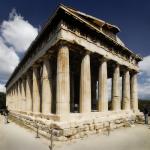|
This section contains 1,417 words (approx. 5 pages at 300 words per page) |

|
The Importance of Athens.
Athens was relatively unimportant in the Mycenaean period, but after the collapse of the Mycenaean world, it dominated the Geometric Period that followed. Sites from the century following 1200 B.C.E. show destruction by fire all over Greece and, for that matter, the Aegean world, but Athens survived. Athenian traditions told that Athens was attacked by the Dorians—a group of Greek people speaking the Dorian dialect—and in the struggle, the last king of Athens, Codrus, sacrificed his life to save the city. Athens and her territory, Attica, remained unconquered and offered a refuge for other dispossessed Greeks. The evidence of Athenian pottery during this period is particularly important, for not only is it the only evidence for the visual arts during the "Dark Ages" that followed Mycenae's collapse, but it contributes a major body...
|
This section contains 1,417 words (approx. 5 pages at 300 words per page) |

|




